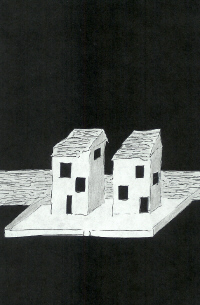
POUSSIERE LINGUISTIQUE
PRECIS
"I feel that there is much to be said for the Celtic belief that the souls of those whom we have lost are held captive in some inferior being, in an animal, in a plant, in some inanimate object, and thus effectively lost to us until the day (which to many never comes) when we happen to pass by a tree or to obtain possession of the object which forms their prison. Then they start and tremble, they call us by our name, and as soon as we have recognised their voice the spell is broken. Delivered by us, they have overcome death and return to share our life." --Marcel Proust, Remembrance of Things Past [1913]
The following is derived from one of several images seen, on a single page of an emblem book, while dreaming. The joint elevation of the two villas resembles and does not resemble a utilitarian apartment block outside my window at the time, seen often, as well, from the fire escape (terrace/balcony) overlooking the parking lot (vineyard) where I would go to smoke ... and to watch the sky. The brick apartment block had once been painted with a yellowish-grey paint and was peeling (shedding the thin veneer of paint, becoming mottled). Shadows penetrated its austere, eastern-facing facade, filling the deeply recessed windows and central, exterior stairwell, at noon on a bright December day, suggestive of moral intrigue versus clarity. The baroque shadow-play dramatically altered the impression of the architectural object, calling into question its explicit rationality. The cubic mass of the building's form, read on the facing elevation, was symmetrically (vertically) bisected by a recessed, three-storey entry bay scaled by an iron stair/fire escape. It was this 'bay', with its structural steel stair, that captured the greater portion of shadows. This implicit 'sea' of shadows is held in reserve by the architectural object itself. While similar to the dream image, the neighboring block was also dissimilar in that it was actually one thing versus apparently two things. The dream image was similar insofar as its apparent duality suggested a singularity. Somewhere in-between was some-thing else. This some-thing else seems to represent (to be) the origin (place of intersection) of the real and the unreal, as one thing, the conceptual 'ground' of the built thing and the unbuilt thing (things). This austere aesthetic, liminal condition seems to embody and disembody, at once, a primary, perhaps elemental relationship between the Absolute (the Abstract) and the Contingent, between type and its corollary, between the universal and the unique (the singular) -- an essentially 'topological' state marked by inversions, incisions, contortions, elisions, and (in time) negation. As topology seems to imply a dialectical twisting and turning, it also confers – after all -- a type of negation of negation. The sites of each complex are wholly dissimilar in that one resides in time and space, within the architectural space (mise en scène) of the town, while the other is a figment of the imagination, residing nowhere (so to speak), but perhaps more real than real. This 'more real than real' indicates a relational condition that is oftimes simply erased (bracketed) by the architectural object (the so-called thing-in-itself of architectural autonomy, a fictive thing-in-itself). The austere reserve (self-referential 'nature') of the architectural object holds in reserve, quite simply, everything else.
The absence of a half-story in the drawings is, in part, the whole story …
GK (12/10/03)